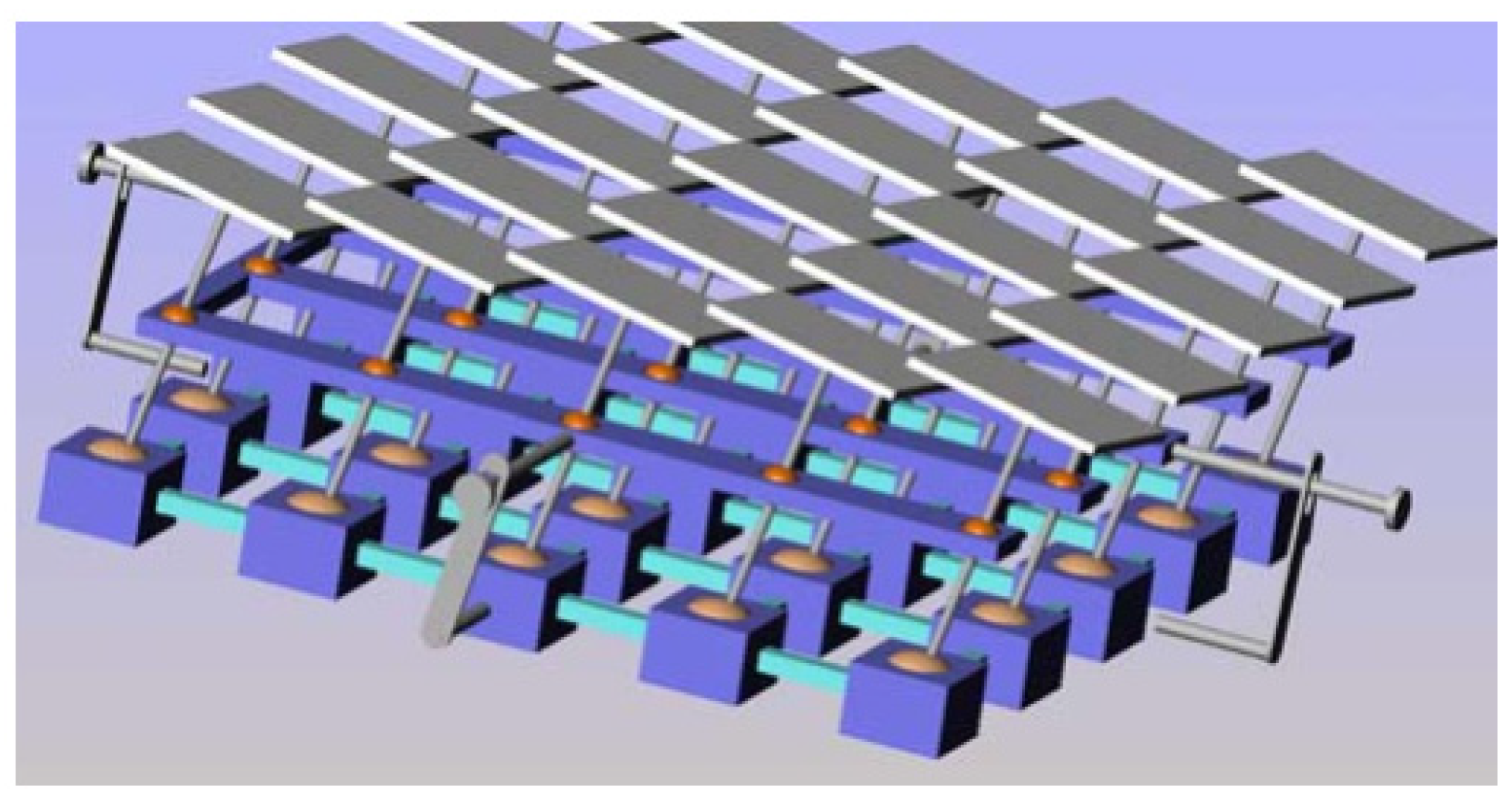Concentrated Solar Thermal Power Technology and Its Thermal Applications
Abstract
1. Introduction
2. Composition of Solar Thermal Power Generation Systems
2.1. Reflector
2.2. Collector
2.3. Heat Storage System
2.3.1. Sensible Heat Storage
2.3.2. Latent Heat Storage
2.3.3. Thermochemical Heat Storage
2.4. Power Generation Systems
2.4.1. Thermal Engine Systems
2.4.2. Direct Thermoelectric Conversion
3. Types of Solar Thermal Power Generation
3.1. Trough Solar Power System
3.2. Tower Solar Power System
3.3. Dish Stirling Solar Power Generation System
3.4. Fresnel Solar Thermal Power Generation System
4. Application of Solar Thermal Systems in Industrial Process Heating
4.1. Energy Demand and Challenges in Industrial Process Heating
4.1.1. Energy Demand for Industrial Process Heating
4.1.2. Potential for Application in the Industrial Sector
4.2. Application Scenarios of Solar Thermal Systems in Industrial Processes
4.2.1. Low-Temperature Application Scenarios
4.2.2. Medium-Temperature Application Scenarios
4.2.3. High-Temperature Application Scenarios
4.3. Economic Effects of Solar Thermal Systems in Industrial Processes
4.3.1. Cost Savings and Investment Return Analysis
4.3.2. Regional and Industry-Specific Differential Benefits
4.3.3. Long-Term Economic Stability and Intangible Value
4.4. Technical Advantages and Challenges in Industrial Applications
4.4.1. Technical Advantages
4.4.2. Technical Challenges
5. Emerging Technologies in Concentrating Solar Thermal Systems
5.1. Innovative Solar Collector Materials
5.2. Thermal Energy Storage (TES) Innovations
6. Conclusions and Outlook
Author Contributions
Funding
Data Availability Statement
Conflicts of Interest
References
- Kabir, E.; Kumar, P.; Kumar, S.; Adelodun, A.A.; Kim, K.-H. Solar energy: Potential and future prospects. Renew. Sustain. Energy Rev. 2018, 82, 894–900. [Google Scholar] [CrossRef]
- Bülow, M.; Pitz-Paal, R. Status and perspectives of concentrating solar technologies. In Energy and Climate Change; Elsevier: Amsterdam, The Netherlands, 2025; pp. 251–277. [Google Scholar]
- Abdullah, M.; Corona, B.H.; Martins, M.; Ferber, N.L.; Armstrong, P.; Chiesa, M.; Calvet, N. Advancements, challenges, and opportunities in the measurement of high heat flux for concentrated solar thermal systems. Sol. Energy 2025, 287, 113252. [Google Scholar] [CrossRef]
- Xu, B.; Ganesan, M.; Devi, R.K.; Ruan, X.; Chen, W.; Lin, C.C.; Chang, H.T.; Lizundia, E.; An, A.K.; Ravi, S.K. Hierarchically Promoted Light Harvesting and Management in Photothermal Solar Steam Generation. Adv. Mater. 2025, 37, 2406666. [Google Scholar] [CrossRef]
- Zhao, S.-S.; Qiu, X.-L.; He, C.-Y.; Yu, D.-M.; Liu, G.; Gao, X.-H. Nanometer-thick high-entropy alloy nitride Al0. 4Hf0. 6NbTaTiZrN-based solar selective absorber coatings. ACS Appl. Nano Mater. 2021, 4, 4504–4512. [Google Scholar] [CrossRef]
- Liu, Q.; Dai, Z.; Wei, Y.; Wang, D.; Xie, Y. Transformative Impacts of AI and Wireless Communication in CSP Heliostat Control Systems. Energies 2025, 18, 1069. [Google Scholar] [CrossRef]
- Sarbu, I.; Dorca, A. Review on heat transfer analysis in thermal energy storage using latent heat storage systems and phase change materials. Int. J. Energy Res. 2019, 43, 29–64. [Google Scholar] [CrossRef]
- Sarbu, I.; Sebarchievici, C. A comprehensive review of thermal energy storage. Sustainability 2018, 10, 191. [Google Scholar] [CrossRef]
- Lovegrove, K.; Stein, W. Concentrating Solar Power Technology: Principles, Developments and Applications; Elsevier: Amsterdam, The Netherlands, 2012. [Google Scholar]
- Mubarrat, M.; Mashfy, M.M.; Farhan, T.; Ehsan, M.M. Research advancement and potential prospects of thermal energy storage in concentrated solar power application. Int. J. Thermofluids 2023, 20, 100431. [Google Scholar] [CrossRef]
- Liu, H.; Shuai, W.; Yao, Z.; Xuan, J.; Ni, M.; Xiao, G.; Xu, H. Optimization of solid oxide electrolysis cells using concentrated solar-thermal energy storage: A hybrid deep learning approach. Appl. Energy 2025, 377, 124610. [Google Scholar] [CrossRef]
- Malwad, D.; Tungikar, V. Development and performance testing of reflector materials for concentrated solar power: A review. Mater. Today Proc. 2021, 46, 539–544. [Google Scholar] [CrossRef]
- Viswanathan, M.; Nagendra, C.; Thutupalli, G. High efficiency front and rear surface silver reflectors. Thin Solid Films 1988, 167, 291–298. [Google Scholar] [CrossRef]
- Goodyear, J.K.; Lindberg, V.L. Low absorption float glass for back surface solar reflectors. Sol. Energy Mater. 1980, 3, 57–67. [Google Scholar] [CrossRef]
- Alder, F.A.; Charrault, E.; Zuber, K.; Fabretto, M.; Patil, A.; Murphy, P.; Llusca, M. Fabrication of robust solar mirrors on polymeric substrates by physical vapor deposition technique. Sol. Energy Mater. Sol. Cells 2020, 209, 110476. [Google Scholar] [CrossRef]
- Hernández, P.; Cruz-Manjarrez, H.; Almanza, R. Multilayer reflective coating for solar energy concentrators. In Proceedings of the ISES World Congress 2007 (Vol. I–Vol. V) Solar Energy and Human Settlement; Springer: Berlin/Heidelberg, Germany, 2007; pp. 1929–1933. [Google Scholar]
- Brogren, M.; Helgesson, A.; Karlsson, B.; Nilsson, J.; Roos, A. Optical properties, durability, and system aspects of a new aluminium-polymer-laminated steel reflector for solar concentrators. Sol. Energy Mater. Sol. Cells 2004, 82, 387–412. [Google Scholar] [CrossRef]
- Tian, Y.; Zhao, C.-Y. A review of solar collectors and thermal energy storage in solar thermal applications. Appl. Energy 2013, 104, 538–553. [Google Scholar] [CrossRef]
- Kalogirou, S.A. Solar thermal collectors and applications. Prog. Energy Combust. Sci. 2004, 30, 231–295. [Google Scholar] [CrossRef]
- Daneshazarian, R.; Cuce, E.; Cuce, P.M.; Sher, F. Concentrating photovoltaic thermal (CPVT) collectors and systems: Theory, performance assessment and applications. Renew. Sustain. Energy Rev. 2018, 81, 473–492. [Google Scholar] [CrossRef]
- Winston, R. Principles of solar concentrators of a novel design. Sol. Energy 1974, 16, 89–95. [Google Scholar] [CrossRef]
- Bellos, E.; Tzivanidis, C. A review of concentrating solar thermal collectors with and without nanofluids. J. Therm. Anal. Calorim. 2018, 135, 763–786. [Google Scholar] [CrossRef]
- Qin, L.; Furbo, S. Solar heating systems with evacuated tubular solar collector. In Proceedings of the EuroSun’98, Portoros, Slovenia, 14–17 September 1998. [Google Scholar]
- Morrison, G.L. Solar collectors. In Solar Energy; Routledge: London, UK, 2013; pp. 163–240. [Google Scholar]
- Wang, F.; Cheng, Z.; Tan, J.; Yuan, Y.; Shuai, Y.; Liu, L. Progress in concentrated solar power technology with parabolic trough collector system: A comprehensive review. Renew. Sustain. Energy Rev. 2017, 79, 1314–1328. [Google Scholar]
- Vant-Hull, L.L. Central tower concentrating solar power systems. In Concentrating Solar Power Technology; Elsevier: Amsterdam, The Netherlands, 2021; pp. 267–310. [Google Scholar]
- Nepveu, F.; Ferriere, A.; Bataille, F. Thermal model of a dish/Stirling systems. Sol. Energy 2009, 83, 81–89. [Google Scholar] [CrossRef]
- Bellos, E. Progress in the design and the applications of linear Fresnel reflectors–A critical review. Therm. Sci. Eng. Prog. 2019, 10, 112–137. [Google Scholar] [CrossRef]
- Wu, C.; Zhao, Y.; Li, W.; Fan, J.; Xu, H.; Yuan, D.; Ling, Z. Layered Operation Optimization Methods for Concentrated Solar Power (CSP) Technology and Multi-Energy Flow Coupling Systems. Energies 2024, 17, 6297. [Google Scholar] [CrossRef]
- Barton, J.P.; Infield, D.G. Energy Storage and Its Use With Intermittent Renewable Energy. IEEE Trans. Energy Convers. 2004, 19, 441–448. [Google Scholar] [CrossRef]
- Izquierdo, S.; Montañés, C.; Dopazo, C.; Fueyo, N. Analysis of CSP plants for the definition of energy policies: The influence on electricity cost of solar multiples, capacity factors and energy storage. Energy Policy 2010, 38, 6215–6221. [Google Scholar] [CrossRef]
- Jorgenson, J.; Denholm, P.; Mehos, M. Estimating the Value of Utility-Scale Solar Technologies in California Under a 40% Renewable Portfolio Standard; Gold. CO: Calabasas, CA, USA, 2014. [Google Scholar]
- Weinstein, L.A.; Loomis, J.; Bhatia, B.; Bierman, D.M.; Wang, E.N.; Chen, G. Concentrating Solar Power. Chem. Rev. 2015, 115, 12797–12838. [Google Scholar] [CrossRef] [PubMed]
- Rafique, M.M.; Rehman, S.; Alhems, L.M. Recent Advancements in High-Temperature Solar Particle Receivers for Industrial Decarbonization. Sustainability 2024, 16, 103. [Google Scholar] [CrossRef]
- Peng, Q.; Yang, X.; Ding, J.; Wei, X.; Yang, J. Design of new molten salt thermal energy storage material for solar thermal power plant. Appl. Energy 2013, 112, 682–689. [Google Scholar] [CrossRef]
- Iniesta, A.C.; Diago, M.; Delclos, T.; Falcoz, Q.; Shamim, T.; Calvet, N. Gravity-fed Combined Solar Receiver/Storage System Using Sand Particles as Heat Collector, Heat Transfer and Thermal Energy Storage Media. Energy Procedia 2015, 69, 802–811. [Google Scholar] [CrossRef]
- Bai, F.; Xu, C. Performance analysis of a two-stage thermal energy storage system using concrete and steam accumulator. Appl. Therm. Eng. 2011, 31, 2764–2771. [Google Scholar] [CrossRef]
- Laing, D.; Steinmann, W.-D.; Tamme, R.; Richter, C. Solid media thermal storage for parabolic trough power plants. Sol. Energy 2006, 80, 1283–1289. [Google Scholar] [CrossRef]
- Khare, S.; Dell’Amico, M.; Knight, C.; McGarry, S. Selection of materials for high temperature sensible energy storage. Sol. Energy Mater. Sol. Cells 2013, 115, 114–122. [Google Scholar] [CrossRef]
- Wang, X.; Liu, J.; Zhang, Y.; Di, H.; Jiang, Y. Experimental research on a kind of novel high temperature phase change storage heater. Energy Convers. Manag. 2006, 47, 2211–2222. [Google Scholar] [CrossRef]
- Petrasch, J.; Klausner, J. Integrated solar thermochemical cycles for energy storage and fuel production. WIREs Energy Environ. 2012, 1, 347–361. [Google Scholar] [CrossRef]
- Felderhoff, M.; Bogdanovic, B. High temperature metal hydrides as heat storage materials for solar and related applications. Int. J. Mol. Sci 2009, 10, 325–344. [Google Scholar] [CrossRef]
- Pardo, P.; Deydier, A.; Anxionnaz-Minvielle, Z.; Rougé, S.; Cabassud, M.; Cognet, P. A review on high temperature thermochemical heat energy storage. Renew. Sustain. Energy Rev. 2014, 32, 591–610. [Google Scholar] [CrossRef]
- Goldsmid, H.J. A Review of: “Applications of Thermoelectricity”. J. Electron. Control 1960, 8, 463. [Google Scholar] [CrossRef]
- Islam, M.T.; Huda, N.; Abdullah, A.B.; Saidur, R. A comprehensive review of state-of-the-art concentrating solar power (CSP) technologies: Current status and research trends. Renew. Sustain. Energy Rev. 2018, 91, 987–1018. [Google Scholar] [CrossRef]
- Fang, Y.; Zhu, Y.; Huang, R. Research on tower-type solar photothermal power generation technology. In IOP Conference Series: Earth and Environmental Science; IOP Publishing: Bristol, UK, 2021; p. 032028. [Google Scholar]
- Kulkarni, K.; Havaldar, S.; Bhattacharya, N. Review on advance tubular receivers for central solar tower system. In IOP Conference Series: Materials Science and Engineering; IOP Publishing: Bristol, UK, 2021; p. 012018. [Google Scholar]
- Zhang, H.L.; Baeyens, J.; Degrève, J.; Cacères, G. Concentrated solar power plants: Review and design methodology. Renew. Sustain. Energy Rev. 2013, 22, 466–481. [Google Scholar] [CrossRef]
- Jebasingh, V.K.; Herbert, G.M.J. A review of solar parabolic trough collector. Renew. Sustain. Energy Rev. 2016, 54, 1085–1091. [Google Scholar] [CrossRef]
- Wang, Z.; Horseman, T.; Straub, A.P.; Yip, N.Y.; Li, D.; Elimelech, M.; Lin, S. Pathways and challenges for efficient solar-thermal desalination. Sci. Adv. 2019, 5, eaax0763. [Google Scholar] [CrossRef] [PubMed]
- Zhao, F.; Zhou, X.; Shi, Y.; Qian, X.; Alexander, M.; Zhao, X.; Mendez, S.; Yang, R.; Qu, L.; Yu, G. Highly efficient solar vapour generation via hierarchically nanostructured gels. Nat. Nanotechnol. 2018, 13, 489–495. [Google Scholar] [CrossRef] [PubMed]
- Alaidaros, A.M.; AlZahrani, A.A. Thermal performance of parabolic trough integrated with thermal energy storage using carbon dioxide, molten salt, and oil. J. Energy Storage 2024, 78, 110084. [Google Scholar] [CrossRef]
- Boretti, A.; Castelletto, S.; Al-Zubaidy, S. Concentrating solar power tower technology: Present status and outlook. Nonlinear Eng. 2019, 8, 10–31. [Google Scholar] [CrossRef]
- Dowling, A.W.; Zheng, T.; Zavala, V.M. Economic assessment of concentrated solar power technologies: A review. Renew. Sustain. Energy Rev. 2017, 72, 1019–1032. [Google Scholar] [CrossRef]
- Kiwan, S.; Khammash, A.L. Optical Performance of a Novel Two-Receiver Solar Central Tower System. J. Sol. Energy Eng. 2020, 142, 011005. [Google Scholar] [CrossRef]
- Göttsche, J.; Hoffschmidt, B.; Schmitz, S.; Sauerborn, M.; Buck, R.; Teufel, E.; Badstübner, K.; Ifland, D.; Rebholz, C. Solar concentrating systems using small mirror arrays. J. Sol. Energy Eng. 2010, 132, 011003. [Google Scholar] [CrossRef]
- Barlev, D.; Vidu, R.; Stroeve, P. Innovation in concentrated solar power. Sol. Energy Mater. Sol. Cells 2011, 95, 2703–2725. [Google Scholar] [CrossRef]
- Mpodi, E.K.; Tjiparuro, Z.; Matsebe, O.; Namoshe, M. A Review of Solar Tracking Mechanisms for Photovoltaic Systems; Botswana International University of Science and Technology: Palapye, Botswana, 2017. [Google Scholar]
- He, C.Y.; Li, Y.; Zhou, Z.H.; Liu, B.H.; Gao, X.H. High-Entropy Photothermal Materials. Adv. Mater. 2024, 36, 2400920. [Google Scholar] [CrossRef]
- Kongtragool, B.; Wongwises, S. A review of solar-powered Stirling engines and low temperature differential Stirling engines. Renew. Sustain. Energy Rev. 2003, 7, 131–154. [Google Scholar] [CrossRef]
- Mancini, T.; Heller, P.; Butler, B.; Osborn, B.; Schiel, W.; Goldberg, V.; Buck, R.; Diver, R.; Andraka, C.; Moreno, J. Dish-Stirling systems: An overview of development and status. J. Sol. Energy Eng. 2003, 125, 135–151. [Google Scholar] [CrossRef]
- Meijer, R. The STM4-120 Stirling Engine for Solar Applications. In Advances in Solar Energy Technology; Elsevier: Amsterdam, The Netherlands, 1988; pp. 1390–1395. [Google Scholar]
- Singh, U.R.; Kumar, A. Review on solar Stirling engine: Development and performance. Therm. Sci. Eng. Prog. 2018, 8, 244–256. [Google Scholar] [CrossRef]
- Mari, M.A.; Memon, Z.A.; Shaikh, P.H.; Mirjat, N.H.; Soomro, M.I. A review study on mathematical modeling of solar parabolic d ish-Stirling system used for electricity generation. Int. J. Energy Res. 2021, 45, 18355–18391. [Google Scholar] [CrossRef]
- Pheng, L.G.; Affandi, R.; Ab Ghani, M.R.; Gan, C.K.; Jano, Z.; Sutikno, T. A review of Parabolic Dish-Stirling Engine System based on concentrating solar power. TELKOMNIKA (Telecommun. Comput. Electron. Control) 2014, 12, 1142–1152. [Google Scholar] [CrossRef]
- Zayed, M.E.; Zhao, J.; Elsheikh, A.H.; Li, W.; Abd Elaziz, M. Optimal design parameters and performance optimization of thermodynamically balanced dish/Stirling concentrated solar power system using multi-objective particle swarm optimization. Appl. Therm. Eng. 2020, 178, 115539. [Google Scholar] [CrossRef]
- Zayed, M.E.; Zhao, J.; Elsheikh, A.H.; Li, W.; Sadek, S.; Aboelmaaref, M.M. A comprehensive review on Dish/Stirling concentrated solar power systems: Design, optical and geometrical analyses, thermal performance assessment, and applications. J. Clean. Prod. 2021, 283, 124664. [Google Scholar] [CrossRef]
- Senthil, R.; Cheralathan, M. Enhancement of the thermal energy storage capacity of a parabolic dish concentrated solar receiver using phase change materials. J. Energy Storage 2019, 25, 100841. [Google Scholar] [CrossRef]
- Baum, V.; Aparasi, R.; Garf, B. High-power solar installations. Sol. Energy 1957, 1, 6–12. [Google Scholar] [CrossRef]
- Francia, G. Pilot plants of solar steam generating stations. Sol. Energy 1968, 12, 51–64. [Google Scholar] [CrossRef]
- Feuermann, D.; Gordon, J. Analysis of a two-stage linear Fresnel reflector solar concentrator. J. Sol. Energy Eng. 1991, 113, 272–279. [Google Scholar] [CrossRef]
- Grena, R.; Tarquini, P. Solar linear Fresnel collector using molten nitrates as heat transfer fluid. Energy 2011, 36, 1048–1056. [Google Scholar] [CrossRef]
- Taramona, S.; González-Gómez, P.Á.; Briongos, J.V.; Gómez-Hernández, J. Designing a flat beam-down linear Fresnel reflector. Renew. Energy 2022, 187, 484–499. [Google Scholar] [CrossRef]
- Grena, R. Geometrical Aspects of the Optics of Linear Fresnel Concentrators: A Review. Energies 2024, 17, 3564. [Google Scholar] [CrossRef]
- Zhai, H.; Dai, Y.; Wu, J.; Wang, R.; Zhang, L. Experimental investigation and analysis on a concentrating solar collector using linear Fresnel lens. Energy Convers. Manag. 2010, 51, 48–55. [Google Scholar] [CrossRef]
- Khan, M.; Alsaduni, I.N.; Alluhaidan, M.; Xia, W.-F.; Ibrahim, M. Evaluating the energy efficiency of a parabolic trough solar collector filled with a hybrid nanofluid by utilizing double fluid system and a novel corrugated absorber tube. J. Taiwan Inst. Chem. Eng. 2021, 124, 150–161. [Google Scholar] [CrossRef]
- Alamdari, P.; Khatamifar, M.; Lin, W. Heat loss analysis review: Parabolic trough and linear Fresnel collectors. Renew. Sustain. Energy Rev. 2024, 199, 114497. [Google Scholar] [CrossRef]
- Xu, Y.; Pei, J.; Yuan, J.; Zhao, G. Concentrated solar power: Technology, economy analysis, and policy implications in China. Environ. Sci. Pollut. Res. 2021, 29, 1324–1337. [Google Scholar] [CrossRef]
- Du, E.; Zhang, N.; Hodge, B.-M.; Kang, C.; Kroposki, B.; Xia, Q. Economic justification of concentrating solar power in high renewable energy penetrated power systems. Appl. Energy 2018, 222, 649–661. [Google Scholar] [CrossRef]
- Ummadisingu, A.; Soni, M.S. Concentrating solar power—Technology, potential and policy in India. Renew. Sustain. Energy Rev. 2011, 15, 5169–5175. [Google Scholar] [CrossRef]
- Elmohlawy, A.E.; Ochkov, V.F.; Kazandzhan, B.I. Thermal performance analysis of a concentrated solar power system (CSP) integrated with natural gas combined cycle (NGCC) power plant. Case Stud. Therm. Eng. 2019, 14, 100458. [Google Scholar] [CrossRef]
- Bansal, N.; Pany, P.; Singh, G. Visual degradation and performance evaluation of utility scale solar photovoltaic power plant in hot and dry climate in western India. Case Stud. Therm. Eng. 2021, 26, 101010. [Google Scholar] [CrossRef]
- Benrezkallah, A.; Marif, Y.; Soudani, M.E.; Belhadj, M.M.; Hamidatou, T.; Mekhloufi, N.; Aouachir, A. Thermal performance evaluation of the parabolic trough solar collector using nanofluids: A case study in the desert of Algeria. Case Stud. Therm. Eng. 2024, 60, 104797. [Google Scholar] [CrossRef]
- Abdelhady, S. Performance and cost evaluation of solar dish power plant: Sensitivity analysis of levelized cost of electricity (LCOE) and net present value (NPV). Renew. Energy 2021, 168, 332–342. [Google Scholar] [CrossRef]
- Bellos, E.; Tzivanidis, C.; Papadopoulos, A. Optical and thermal analysis of a linear Fresnel reflector operating with thermal oil, molten salt and liquid sodium. Appl. Therm. Eng. 2018, 133, 70–80. [Google Scholar] [CrossRef]
- Zhang, C.; Xu, Q.; Zhang, Y.; Arauzo, I.; Zou, C. Performance analysis of different arrangements of a new layout dish-Stirling system. Energy Rep. 2021, 7, 1798–1807. [Google Scholar] [CrossRef]
- Kumar, K.R.; Chaitanya, N.V.K.; Kumar, N.S. Solar thermal energy technologies and its applications for process heating and power generation–A review. J. Clean. Prod. 2021, 282, 125296. [Google Scholar] [CrossRef]
- Bellos, E.; Bousi, E.; Tzivanidis, C.; Pavlovic, S. Optical and thermal analysis of different cavity receiver designs for solar dish concentrators. Energy Convers. Manag. X 2019, 2, 100013. [Google Scholar] [CrossRef]
- Modi, A.; Bühler, F.; Andreasen, J.G.; Haglind, F. A review of solar energy based heat and power generation systems. Renew. Sustain. Energy Rev. 2017, 67, 1047–1064. [Google Scholar] [CrossRef]
- Aboelwafa, O.; Fateen, S.-E.K.; Soliman, A.; Ismail, I.M. A review on solar Rankine cycles: Working fluids, applications, and cycle modifications. Renew. Sustain. Energy Rev. 2018, 82, 868–885. [Google Scholar] [CrossRef]
- Schnitzer, H.; Brunner, C.; Gwehenberger, G. Minimizing greenhouse gas emissions through the application of solar thermal energy in industrial processes. J. Clean. Prod. 2007, 15, 1271–1286. [Google Scholar] [CrossRef]
- Farjana, S.H.; Huda, N.; Mahmud, M.A.P.; Saidur, R. Solar process heat in industrial systems—A global review. Renew. Sustain. Energy Rev. 2018, 82, 2270–2286. [Google Scholar] [CrossRef]
- Ramaiah, R.; Shekar, K.S. Solar thermal energy utilization for medium temperature industrial process heat applications—A review. In IOP Conference Series: Materials Science and Engineering; IOP Publishing: Bristol, UK, 2018; p. 012035. [Google Scholar]
- Kalogirou, S. The potential of solar industrial process heat applications. Appl. Energy 2003, 76, 337–361. [Google Scholar] [CrossRef]
- Kumar, L.; Hasanuzzaman, M.; Rahim, N. Global advancement of solar thermal energy technologies for industrial process heat and its future prospects: A review. Energy Convers. Manag. 2019, 195, 885–908. [Google Scholar] [CrossRef]
- Kylili, A.; Fokaides, P.A.; Ioannides, A.; Kalogirou, S. Environmental assessment of solar thermal systems for the industrial sector. J. Clean. Prod. 2018, 176, 99–109. [Google Scholar] [CrossRef]
- Koçak, B.; Fernandez, A.I.; Paksoy, H. Review on sensible thermal energy storage for industrial solar applications and sustainability aspects. Sol. Energy 2020, 209, 135–169. [Google Scholar] [CrossRef]
- Atkins, M.J.; Walmsley, M.R.; Morrison, A.S. Integration of solar thermal for improved energy efficiency in low-temperature-pinch industrial processes. Energy 2010, 35, 1867–1873. [Google Scholar] [CrossRef]
- Gajendiran, M.; Nallusamy, N. Application of Solar Thermal Energy Storage for Industrial Process Heating. Adv. Mater. Res. 2014, 984–985, 725–729. [Google Scholar] [CrossRef]
- Malinowski, M.; Leon, J.I.; Abu-Rub, H. Solar Photovoltaic and Thermal Energy Systems: Current Technology and Future Trends. Proc. IEEE 2017, 105, 2132–2146. [Google Scholar] [CrossRef]
- Mekhilef, S.; Saidur, R.; Safari, A. A review on solar energy use in industries. Renew. Sustain. Energy Rev. 2011, 15, 1777–1790. [Google Scholar] [CrossRef]
- Phani Kumar, K.K.; Mallick, S.; Sakthivel, S. Nanoparticles based single and tandem stable solar selective absorber coatings with wide angular solar absorptance. Sol. Energy Mater. Sol. Cells 2022, 242, 111758. [Google Scholar] [CrossRef]

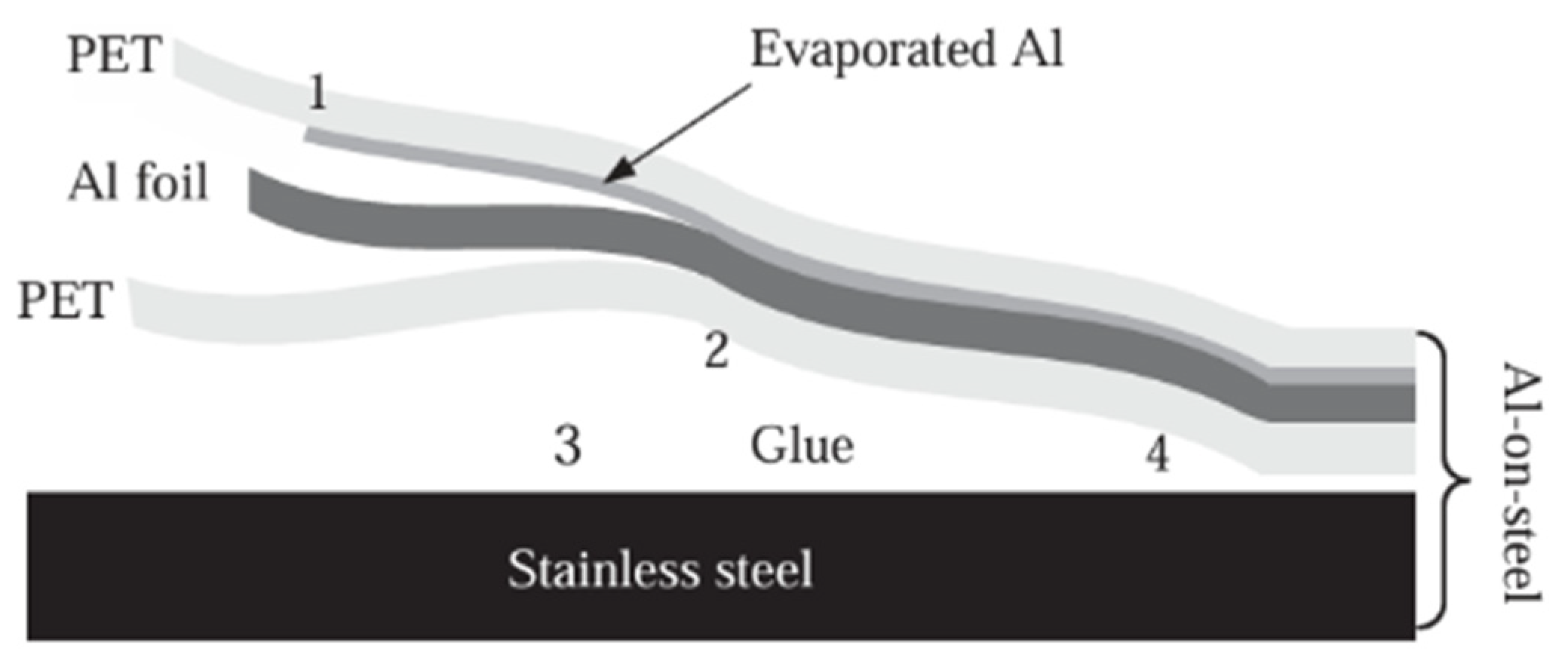
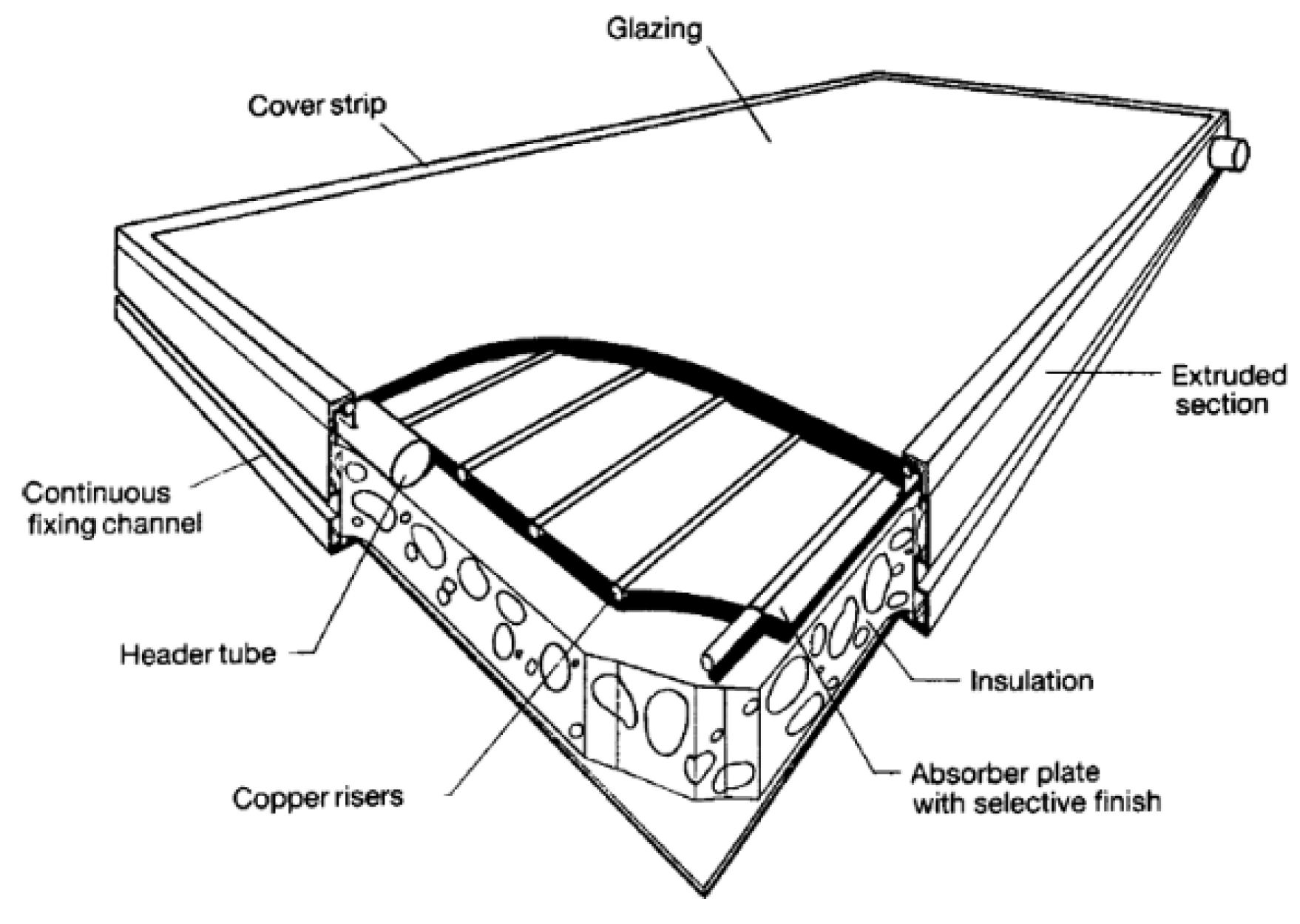

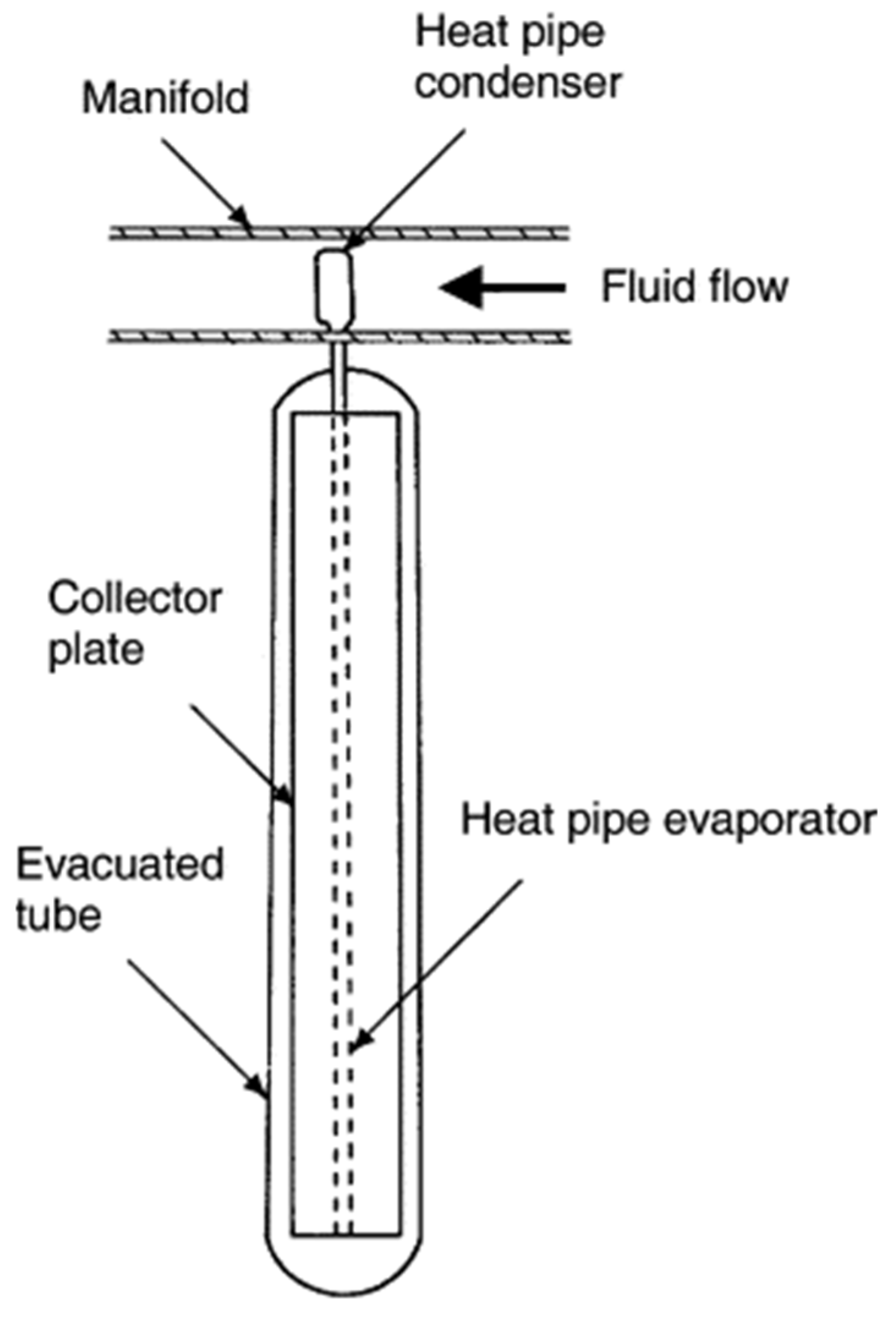
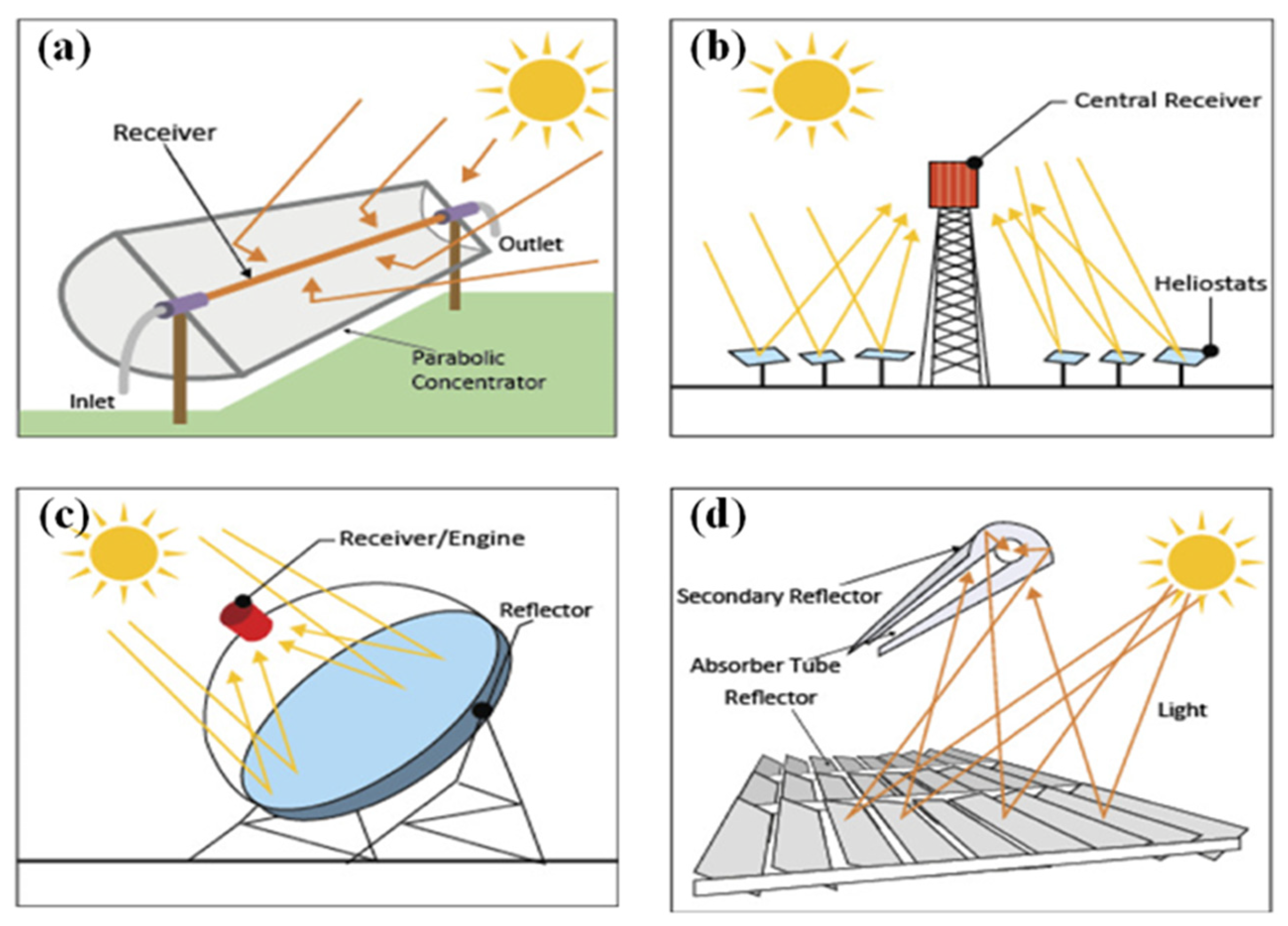
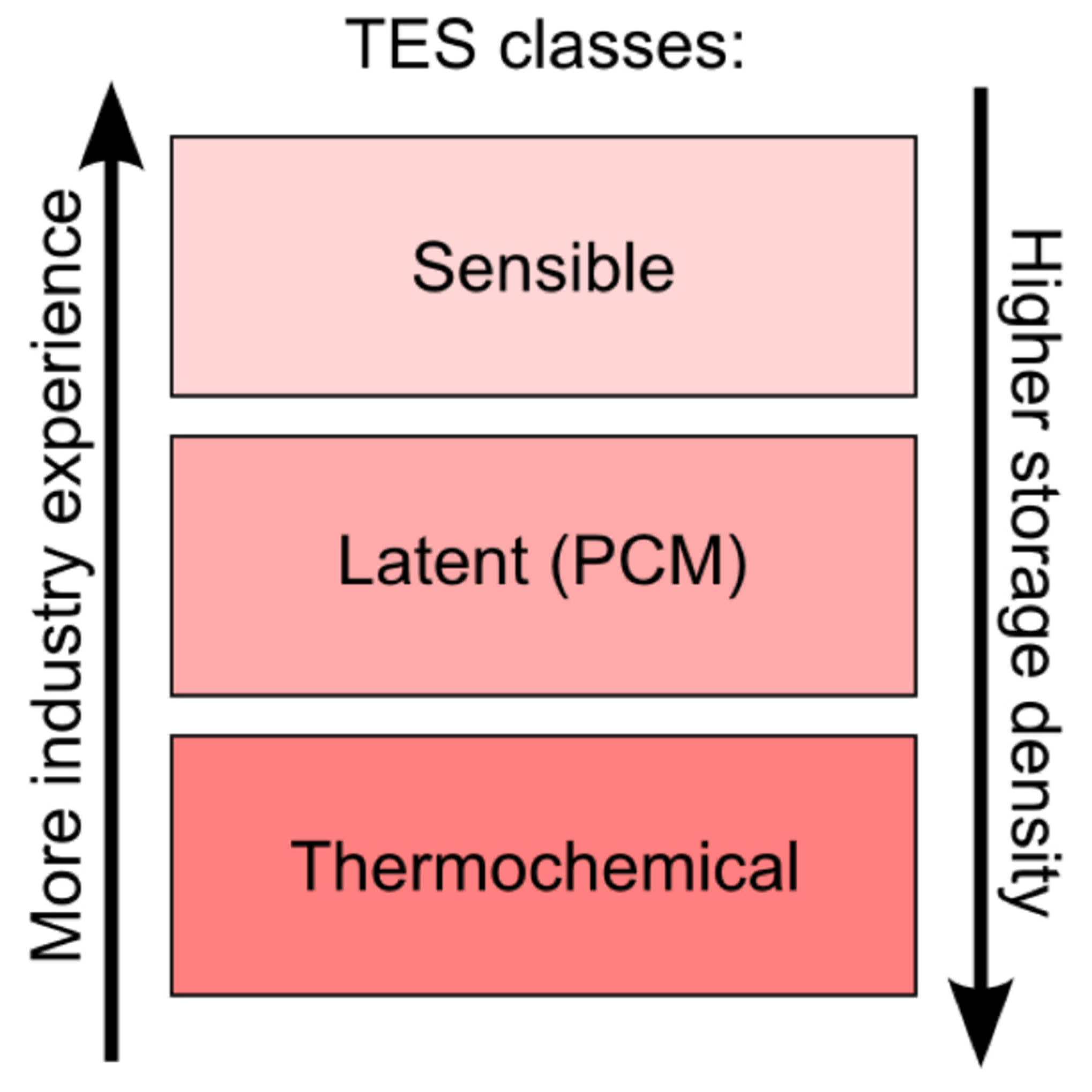
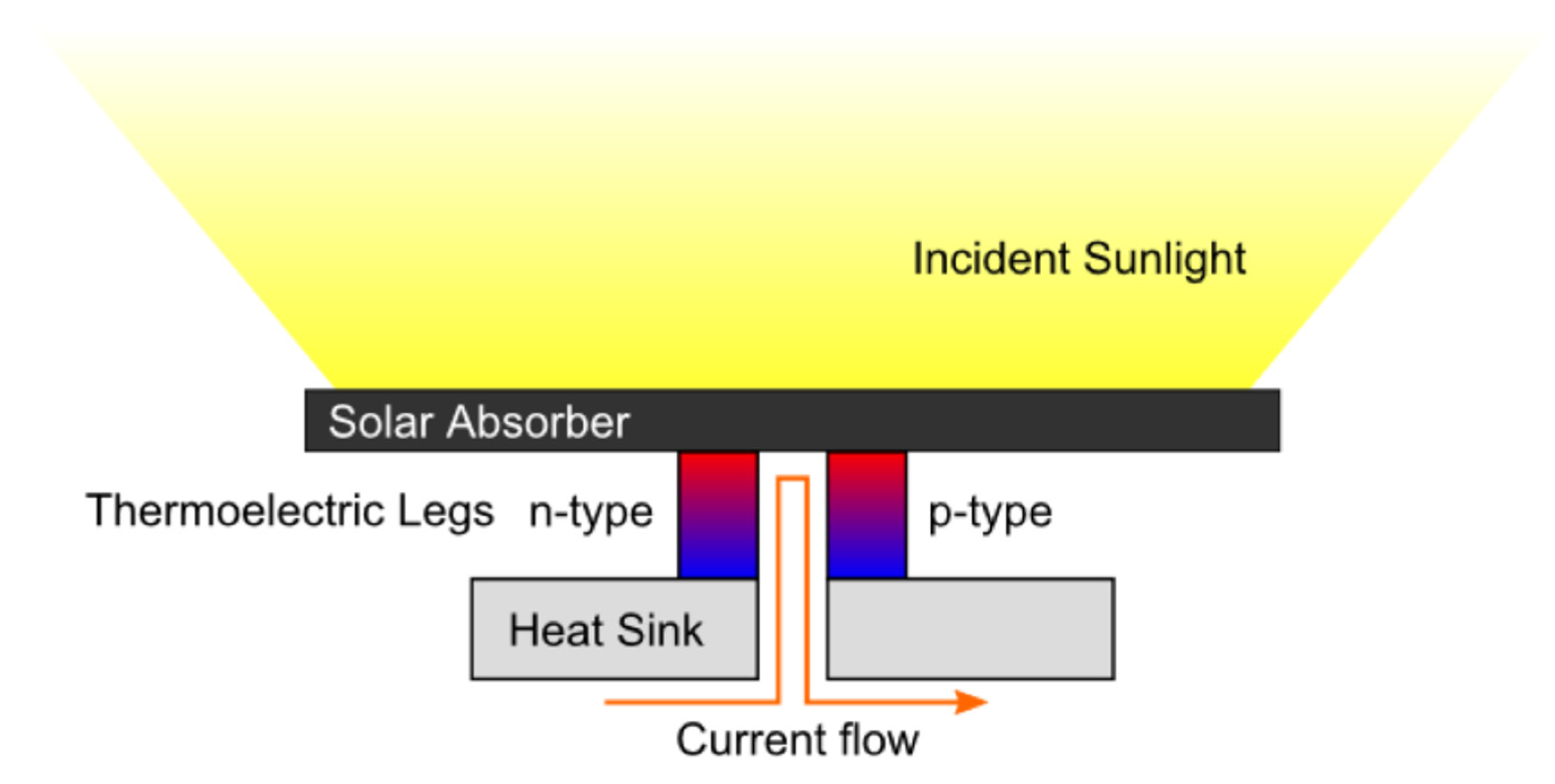
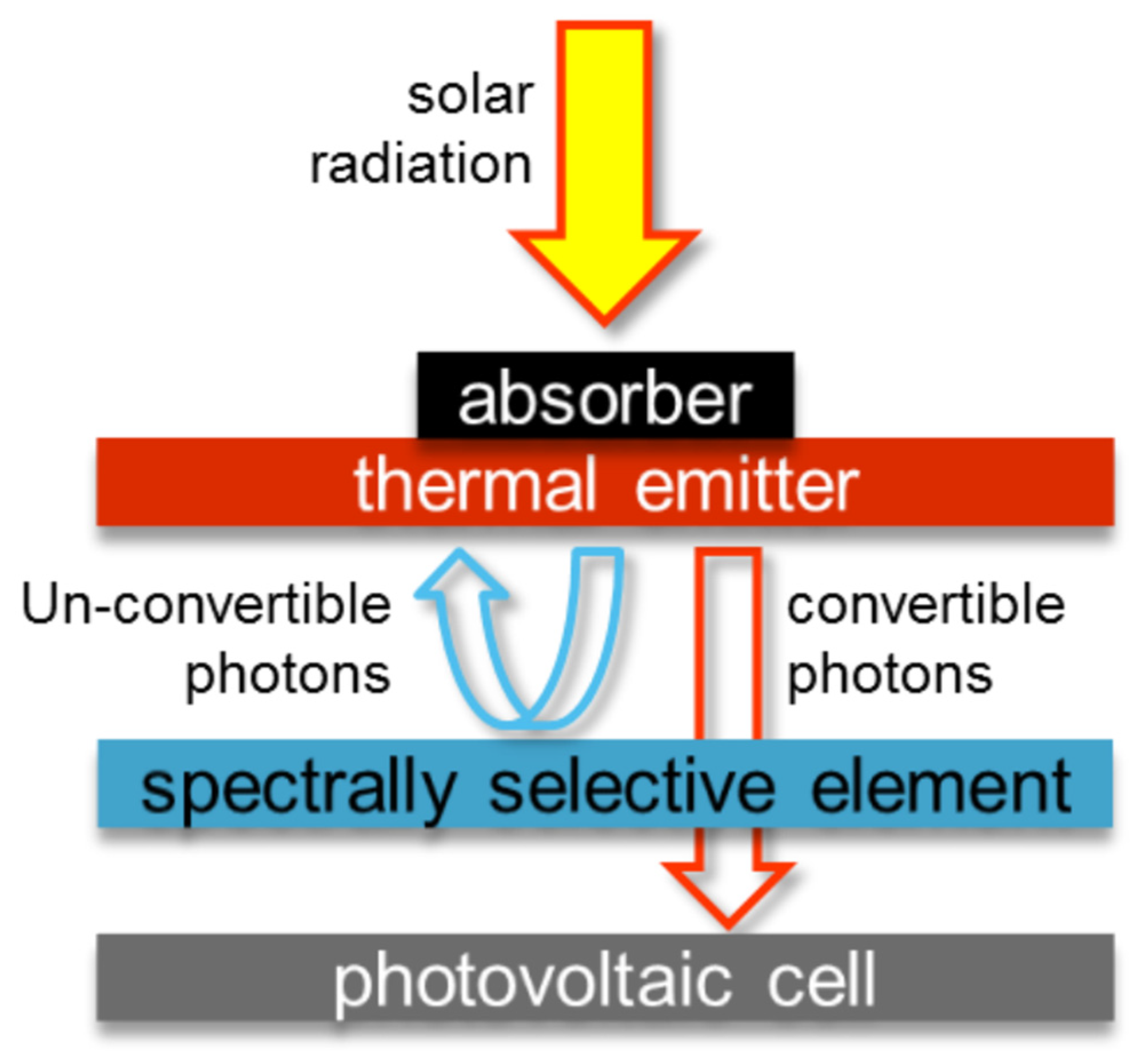
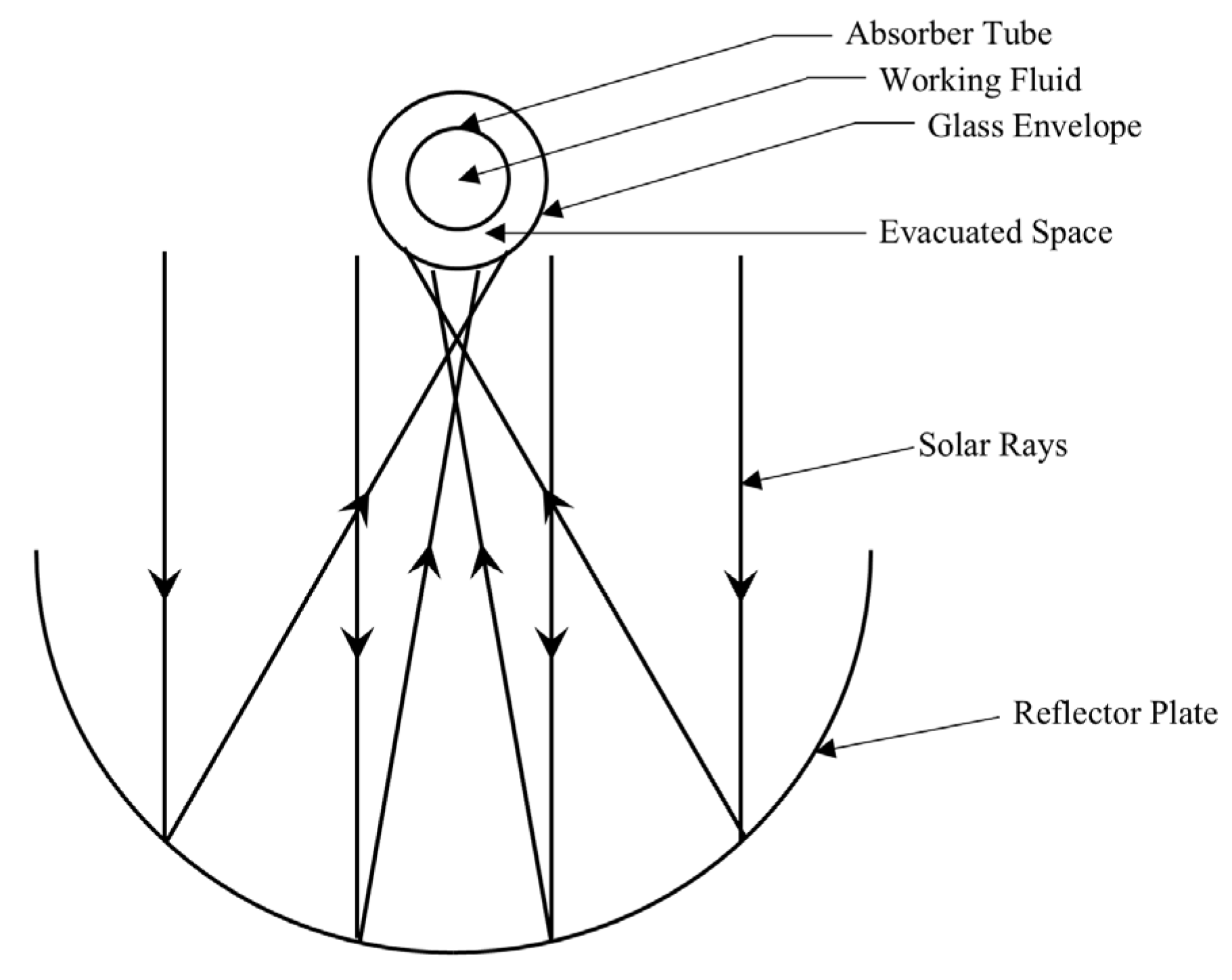

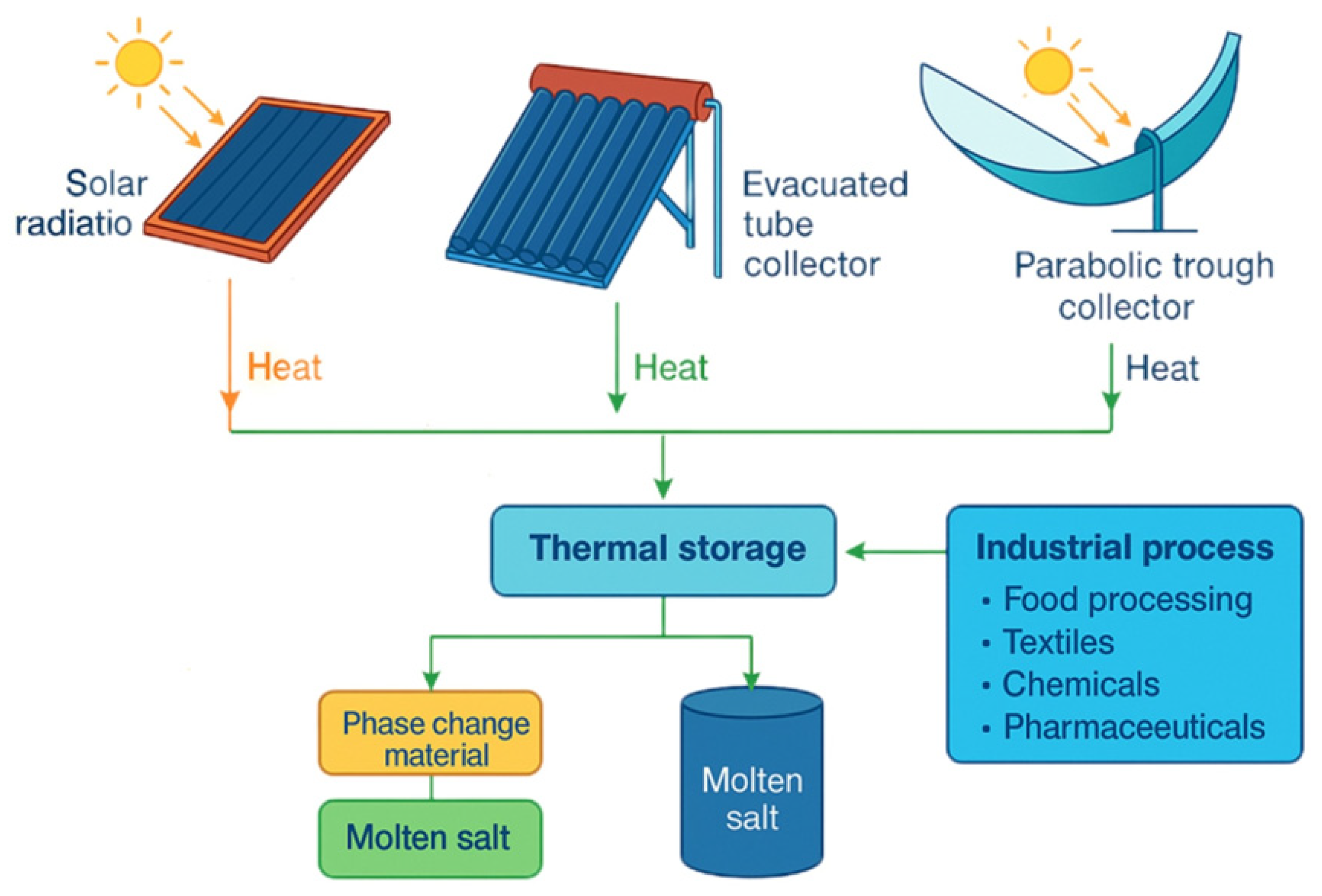




| Technology Type | Description | Advantages | Challenges |
|---|---|---|---|
| Parabolic Trough Solar Power | Mirrors focus sunlight onto pipes, heating a fluid to produce steam that drives a turbine for power generation. | Mature technology, suitable for large-scale power generation. | Requires large land area, highly weather dependent. |
| Solar Power Tower | Mirrors focus sunlight onto pipes, heating a fluid to produce steam that drives a turbine for power generation. | High efficiency, capable of generating power around the clock. | High initial construction cost, large land requirements. |
| Parabolic Dish Solar Power | Flat mirrors concentrate sunlight onto a collector to generate steam that drives a turbine for power generation. | Low cost, suitable for medium- to small-scale projects. | Lower efficiency, performance not as good as trough and tower systems. |
| Carbide Concentrated System | Parabolic dish mirrors concentrate sunlight to drive a Stirling engine for power generation. | High efficiency, suitable for distributed generation. | High maintenance, large initial investment. |
| Solar Multi-Receiver Collection System | Multiple heliostats focus sunlight onto a high tower receiver, and heat transfer drives a turbine for power generation. | High efficiency, suitable for large-scale generation, and peak load management. | High cost, complex technology, requires precise tracking. |
| Capacity (MW) | Installation Cost | Power Generation Efficiency (%) | Cost of Electricity (USD/kWh) | Thermal Loss Coefficient | Optical Efficiency Attenuation Rate | |
|---|---|---|---|---|---|---|
| Trough solar power system | 10–200 | Low | 13–18 | 0.17 | High (significant radiation and conduction losses) | Relatively high (affected by radiation and weather variations) |
| Tower solar power system | 10–200 | High | 16–17 | 0.14 | Low (highly efficient light concentration) | Low (precise optical design) |
| Dish Stirling Solar Power Generation System | 0.01–0.4 | High | 20–30 | 0.15 | High (large collector area and Stirling engine thermal losses) | High (significantly affected by external environmental changes) |
| Fresnel Solar Thermal Power Generation System | 10–200 | Low | 8–11 | 0.14 | Moderate (relatively high optical component efficiency) | Relatively low (influenced by dust accumulation on mirrors) |
| Temperature Divisione | Industrial Type | Application |
|---|---|---|
| Low (<100 °C) | Food industry | Wash, pasteurize, and disinfect |
| Textile industry | Dyeing, rinsing, and washing | |
| Chemical industry | Low-temperature evaporation, dissolution, and cleaning | |
| Medium (100–250 °C) | Paper industry | Pulp drying, heat treatment |
| Beverage industry | Wash and pasteurize | |
| Chemical and pharmaceutical industries | Solvent evaporation, chemical reaction, and distillation | |
| High (<250 °C) | Metalworking industry | Metal melting, heat treatment |
| Chemical industry | Pyrolysis, gasification, and synthesis at high temperature |
Disclaimer/Publisher’s Note: The statements, opinions and data contained in all publications are solely those of the individual author(s) and contributor(s) and not of MDPI and/or the editor(s). MDPI and/or the editor(s) disclaim responsibility for any injury to people or property resulting from any ideas, methods, instructions or products referred to in the content. |
© 2025 by the authors. Licensee MDPI, Basel, Switzerland. This article is an open access article distributed under the terms and conditions of the Creative Commons Attribution (CC BY) license (https://creativecommons.org/licenses/by/4.0/).
Share and Cite
Wu, C.; Zhao, Y.; Li, W.; Fan, J.; Xu, H.; Ling, Z.; Yuan, D.; Zeng, X. Concentrated Solar Thermal Power Technology and Its Thermal Applications. Energies 2025, 18, 2120. https://doi.org/10.3390/en18082120
Wu C, Zhao Y, Li W, Fan J, Xu H, Ling Z, Yuan D, Zeng X. Concentrated Solar Thermal Power Technology and Its Thermal Applications. Energies. 2025; 18(8):2120. https://doi.org/10.3390/en18082120
Chicago/Turabian StyleWu, Chunchao, Yonghong Zhao, Wulin Li, Jianjun Fan, Haixiang Xu, Zhongqian Ling, Dingkun Yuan, and Xianyang Zeng. 2025. "Concentrated Solar Thermal Power Technology and Its Thermal Applications" Energies 18, no. 8: 2120. https://doi.org/10.3390/en18082120
APA StyleWu, C., Zhao, Y., Li, W., Fan, J., Xu, H., Ling, Z., Yuan, D., & Zeng, X. (2025). Concentrated Solar Thermal Power Technology and Its Thermal Applications. Energies, 18(8), 2120. https://doi.org/10.3390/en18082120








